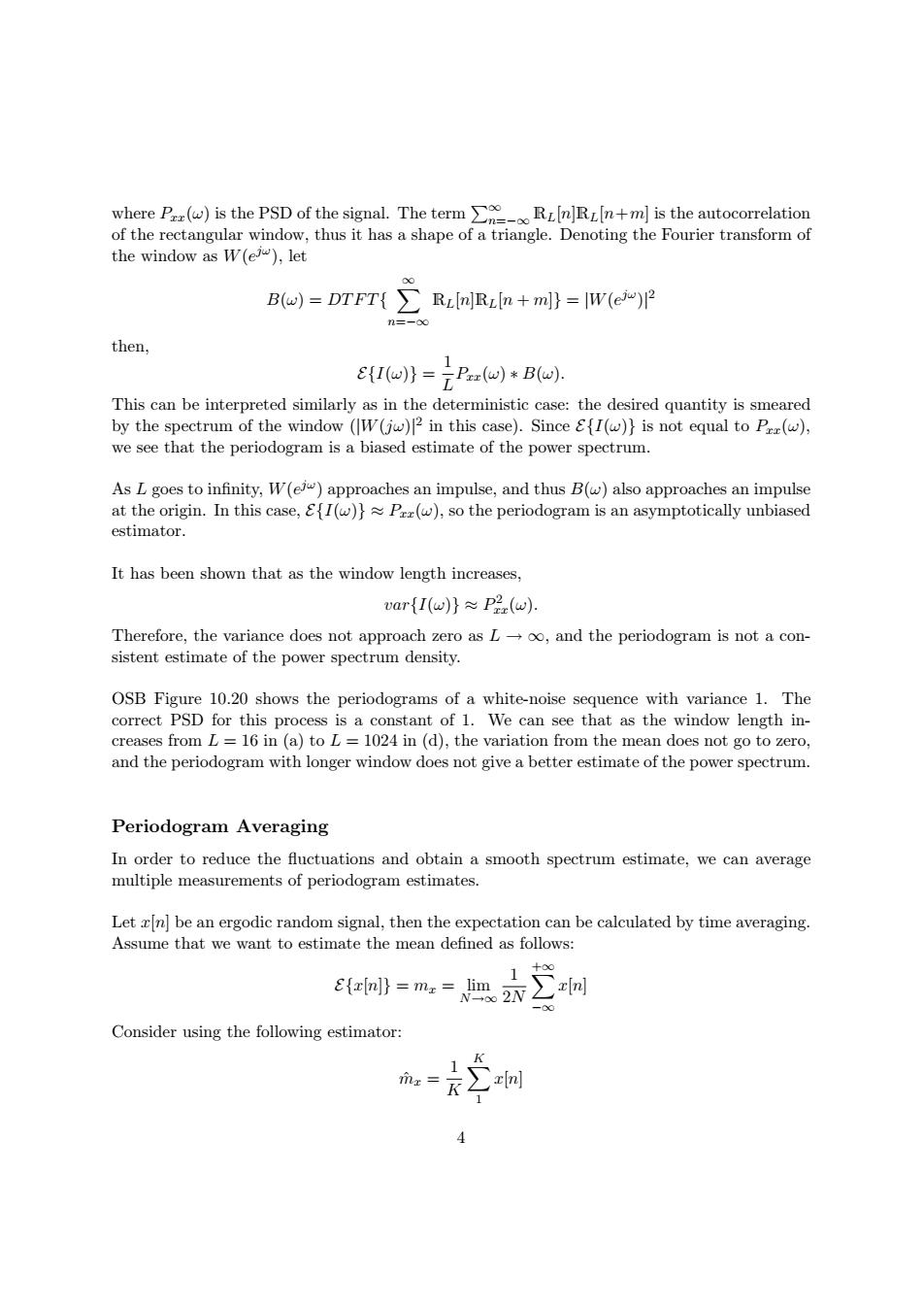正在加载图片...

where P)isthe PSD of the signal.The termmisthe autocorrelation of the rectangular window,thus it has a shape of a triangle.Denoting the Fourier transform of the window as W(e),let B(w)=DTFT RL[n]RLIn m]}=W(ej)2 n=-00 then, E(I())=P(w)+B(w). This can be interpreted similarly as in the deterministic case:the desired quantity is smeared by the spectrum of the window (W(jw)2 in this case).Since Efl(w)}is not equal to Pw), we see that the periodogram is a biased estimate of the power spectrum. As L goes to infinity,W(e)approaches an impulse,and thus B(w)also approaches an impulse at the origin.In this case,EfI(w)Pr(w),so the periodogram is an asymptotically unbiased estimator. It has been shown that as the window length increases, var{I(w)}≈P2(w). Therefore,the variance does not approach zero as Loo,and the periodogram is not a con- sistent estimate of the power spectrum density. OSB Figure 10.20 shows the periodograms of a white-noise sequence with variance 1.The correct PSD for this process is a constant of 1.We can see that as the window length in- creases from L 16 in (a)to L 1024 in (d),the variation from the mean does not go to zero, and the periodogram with longer window does not give a better estimate of the power spectrum. Periodogram Averaging In order to reduce the fluctuations and obtain a smooth spectrum estimate,we can average multiple measurements of periodogram estimates. Let r[n]be an ergodic random signal,then the expectation can be calculated by time averaging. Assume that we want to estimate the mean defined as follows: Nim 2rinl Efxn]}=mz=lim -0 Consider using the following estimator: xn] 4where Pxx(ω) is the PSD of the signal. The term �∞ RL[n]RL[n+m] is the autocorrelation n=−∞ of the rectangular window, thus it has a shape of a triangle. Denoting the Fourier transform of the window as W(ejω), let ∞ B(ω) = DTFT{ � RL[n]RL[n + m]} = |W(ejω) 2 | n=−∞ then, 1 E{I(ω)} = Pxx(ω) ∗ B(ω). L This can be interpreted similarly as in the deterministic case: the desired quantity is smeared by the spectrum of the window ( W(jω) 2 | | in this case). Since E{I(ω)} is not equal to Pxx(ω), we see that the periodogram is a biased estimate of the power spectrum. As L goes to infinity, W(ejω) approaches an impulse, and thus B(ω) also approaches an impulse at the origin. In this case, E{I(ω)} ≈ Pxx(ω), so the periodogram is an asymptotically unbiased estimator. It has been shown that as the window length increases, xx var{I(ω)} ≈ P (ω). 2 Therefore, the variance does not approach zero as L → ∞, and the periodogram is not a consistent estimate of the power spectrum density. OSB Figure 10.20 shows the periodograms of a white-noise sequence with variance 1. The correct PSD for this process is a constant of 1. We can see that as the window length increases from L = 16 in (a) to L = 1024 in (d), the variation from the mean does not go to zero, and the periodogram with longer window does not give a better estimate of the power spectrum. Periodogram Averaging In order to reduce the fluctuations and obtain a smooth spectrum estimate, we can average multiple measurements of periodogram estimates. Let x[n] be an ergodic random signal, then the expectation can be calculated by time averaging. Assume that we want to estimate the mean defined as follows: +∞ 1 E{x[n]} = mx = lim �x[n] N→∞ 2N −∞ Consider using the following estimator: 1 K mˆ x = �x[n] K 1 4